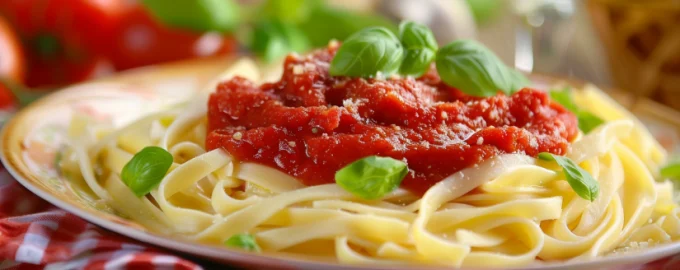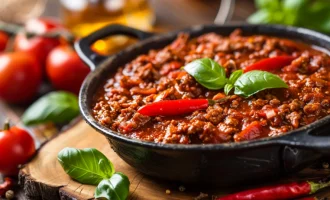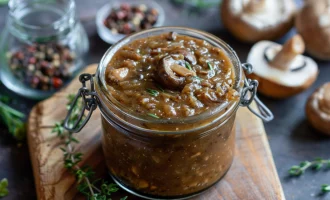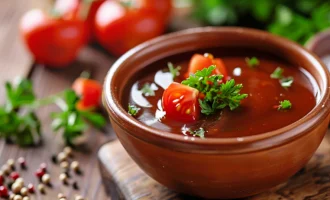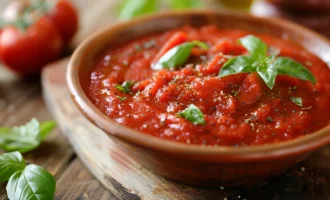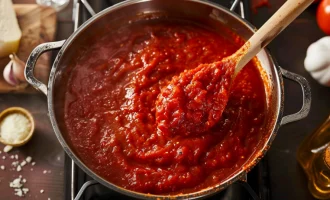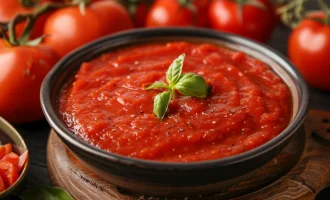Tomato paste sauce for pasta is a staple in Italian cuisine, tracing its origins back to the late 17th century after tomatoes were introduced to Europe from the Americas. Initially met with suspicion, tomatoes eventually became a beloved ingredient, giving rise to the classic tomato sauce that graces pasta dishes worldwide today. This sauce, with its rich, concentrated tomato flavor, serves as the foundation for many variations, including marinara and arrabbiata. It pairs beautifully with a wide range of pasta, from spaghetti to penne, and is a versatile base for adding meats, vegetables, and herbs.
- Tomato paste 150 g
- Olive oil 30 g
- Finely chopped onion 100 g
- Garlic cloves 10 g
- Water 500 ml
- Dried oregano 2 g
- Dried basil 2 g
- Sugar 5 g
- Salt 5 g
- Freshly ground black pepper 2 g
- In a large saucepan, heat the olive oil over medium heat. Add the finely chopped onion and sauté until translucent, about 5 minutes. Add the minced garlic and cook for an additional minute, until fragrant.
- Stir in the tomato paste to the onion and garlic mixture. Cook for 2-3 minutes, stirring constantly, to deepen the flavors.
- Slowly add the water to the saucepan, stirring to integrate the tomato paste until a smooth consistency is achieved. Bring to a simmer.
- Add the dried oregano, dried basil, sugar, salt, and freshly ground black pepper. Stir well to combine all the ingredients.
- Reduce the heat to low and let the sauce simmer, uncovered, for 20-25 minutes, or until it reaches your desired thickness, stirring occasionally.
- Taste the sauce and adjust the seasoning if necessary. If the sauce is too thick, add a little more water until the preferred consistency is reached.
- Combine the sauce with your cooked pasta of choice, mix well, and serve immediately. Garnish with fresh basil or grated Parmesan cheese if desired.
Storage Tips
The sauce can be stored in an airtight container in the refrigerator for up to 5 days or frozen for up to 3 months. Thaw overnight in the refrigerator and reheat on the stove over low heat, adding a bit of water if the sauce has thickened too much during storage.
Useful Properties of Tomato Paste
Tomato paste is rich in lycopene, a powerful antioxidant that has been linked to numerous health benefits, including reduced risk of heart disease and cancer. It is also a good source of vitamins C and K, potassium, and folate, making it a nutritious addition to meals.
Interesting Facts
- Concentration Process: Tomato paste is made by cooking down tomatoes to remove the water content, concentrating the flavors and nutrients.
- Global Staple: While tomato paste and tomato-based sauces are integral to Italian cuisine, they are also used worldwide in various dishes, highlighting the versatility and universal appeal of tomatoes.
- Historical Resistance: Despite its now-central role in Italian cuisine, the tomato was once thought to be poisonous in Europe due to its relation to the nightshade family.
Tomato paste sauce for pasta exemplifies the simplicity and elegance of Italian cooking, transforming basic ingredients into a rich, flavorful, and comforting dish. Whether tossed with spaghetti for a quick weeknight meal or used as a base for a more elaborate pasta creation, this sauce is a testament to the enduring appeal of the humble tomato.

